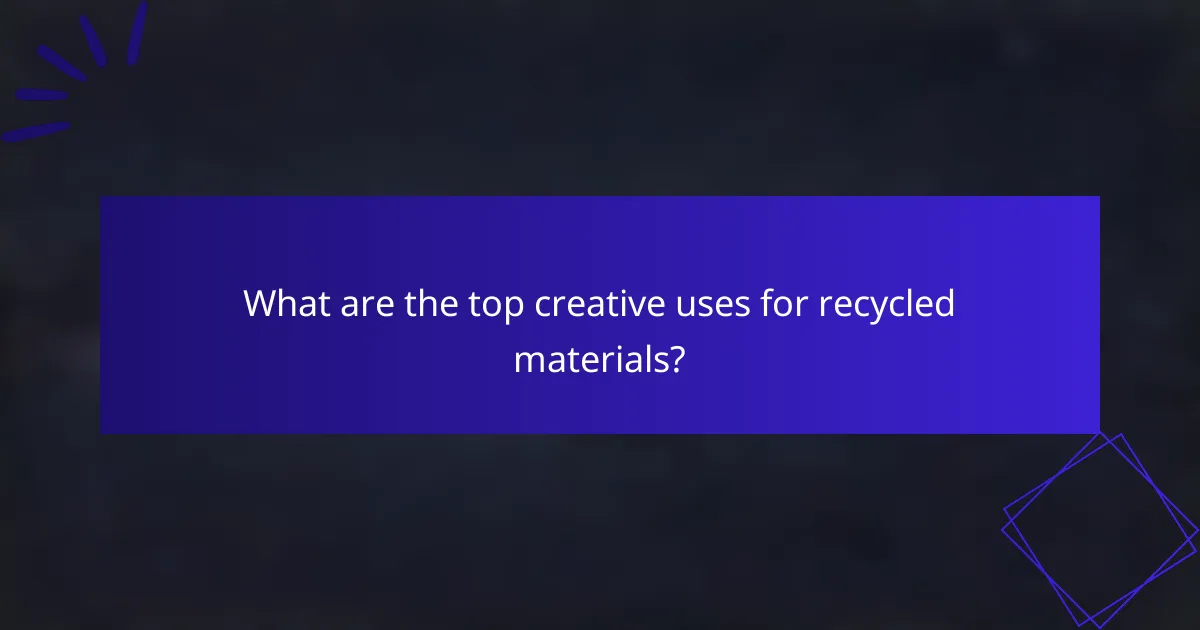When embarking on creative projects, selecting materials that offer both versatility and inspiration is crucial. Options like cotton, wood, metal, plastic, and glass each bring unique characteristics that can elevate your work. By considering project requirements, environmental impact, and budget, you can make informed choices that not only enhance creativity but also align with sustainable practices.

What materials are best for versatility and creativity?
Materials that excel in versatility and creativity include cotton, wood, metal, plastic, and glass. Each of these materials offers unique properties that can enhance various projects, making them suitable for a wide range of applications.
Cotton for flexibility
Cotton is a highly flexible material, making it ideal for a variety of creative projects, from clothing to home decor. Its natural fibers allow for easy manipulation, dyeing, and printing, which can enhance artistic expression.
When choosing cotton, consider the weight and weave. Lightweight cotton is great for garments, while heavier options work well for upholstery. Always pre-wash cotton to prevent shrinkage in finished products.
Wood for structural integrity
Wood is renowned for its structural integrity, making it a staple in furniture and construction. Its strength-to-weight ratio allows for sturdy designs while maintaining a natural aesthetic.
Different types of wood offer varying levels of durability and workability. Hardwoods like oak and maple are excellent for long-lasting furniture, while softwoods like pine are easier to work with for beginners. Always consider the intended use when selecting wood types.
Metal for durability
Metal is a durable material that can withstand wear and tear, making it suitable for both functional and artistic applications. Common metals include steel, aluminum, and copper, each offering unique properties.
When working with metal, consider its weight and corrosion resistance. For outdoor projects, stainless steel or aluminum is preferable due to their resistance to rust. Always use appropriate safety gear when cutting or welding metal.
Plastic for moldability
Plastic is highly moldable, allowing for intricate designs and shapes that other materials may not accommodate. It is lightweight and can be easily colored, making it popular in crafts and product design.
Different types of plastic, such as PVC and acrylic, have varying levels of flexibility and strength. Consider the application and environmental impact when choosing plastic, as some types are more recyclable than others.
Glass for aesthetics
Glass is valued for its aesthetic appeal, offering clarity and elegance in design. It can be used in art, architecture, and functional items like tableware, providing a unique visual element.
When working with glass, consider its thickness and treatment. Tempered glass is stronger and safer for functional use, while stained glass can add artistic flair. Always handle glass with care to avoid breakage and injury.

How to choose materials for creative projects?
Choosing materials for creative projects involves understanding the specific needs of your project, the environmental implications of your choices, and the overall cost. By carefully evaluating these factors, you can select versatile materials that enhance creativity while remaining practical.
Assess project requirements
Begin by identifying the specific requirements of your project, such as durability, flexibility, and aesthetic appeal. For example, if you are creating outdoor furniture, you will need weather-resistant materials, while a sculpture may require materials that allow for intricate detailing.
Consider the intended use and lifespan of the project. Materials that are lightweight and easy to manipulate may be ideal for temporary installations, while heavier, more robust options are better suited for permanent structures.
Consider environmental impact
Evaluate the environmental impact of your material choices by looking for sustainable options. Materials like bamboo, recycled metals, and organic cotton are often more eco-friendly than conventional alternatives. Research certifications such as FSC (Forest Stewardship Council) for wood products or GOTS (Global Organic Textile Standard) for textiles to ensure sustainability.
Be mindful of the lifecycle of materials, including sourcing, production, and disposal. Opting for local materials can reduce transportation emissions and support local economies, making your project more sustainable.
Evaluate cost-effectiveness
Cost-effectiveness is crucial when selecting materials for creative projects. Start by setting a budget and researching material prices in your area. Keep in mind that while some materials may have a higher upfront cost, they can save money in the long run through durability and reduced maintenance.
Consider bulk purchasing options or local suppliers to lower costs. Additionally, explore alternative materials that can achieve similar effects at a lower price point, such as using reclaimed wood instead of new lumber.

What are the benefits of using sustainable materials?
Using sustainable materials offers numerous advantages, including reduced environmental impact, improved brand image, and potential cost savings over time. These materials are sourced responsibly, promoting ecological balance and appealing to environmentally conscious consumers.
Reduced environmental footprint
Sustainable materials typically have a lower environmental footprint compared to conventional options. They are often produced using renewable resources, which helps conserve natural habitats and reduce pollution. For instance, materials like bamboo or recycled plastics can significantly minimize waste and energy consumption during production.
When selecting materials, consider certifications such as FSC (Forest Stewardship Council) for wood products or GOTS (Global Organic Textile Standard) for textiles. These labels indicate adherence to environmental standards, ensuring that your choices contribute positively to the planet.
Enhanced brand reputation
Utilizing sustainable materials can bolster your brand’s reputation by aligning it with eco-friendly values. Consumers are increasingly drawn to brands that demonstrate a commitment to sustainability, which can lead to increased loyalty and market share. For example, companies that use organic cotton or recycled materials often attract a dedicated customer base.
To enhance your brand’s image, communicate your sustainable practices clearly through marketing materials and product labels. Transparency about sourcing and production processes can further strengthen consumer trust and engagement.
Long-term cost savings
Investing in sustainable materials can lead to long-term cost savings, despite potential higher upfront costs. These materials often offer greater durability and efficiency, reducing the need for frequent replacements or repairs. For example, energy-efficient materials can lower utility bills over time.
Consider lifecycle costs when evaluating materials. While initial expenses may be higher, the overall savings from reduced waste, energy consumption, and maintenance can be substantial. Additionally, many governments offer incentives for businesses that adopt sustainable practices, further enhancing financial benefits.

What are the top creative uses for recycled materials?
Recycled materials can be creatively repurposed in various projects, enhancing sustainability while showcasing artistic flair. From home decor to functional furniture, these materials offer versatility and uniqueness in design.
Home decor projects
Recycled materials can transform ordinary spaces into extraordinary ones. Items like glass jars, old wood, and fabric scraps can be used to create unique wall art, decorative vases, or even upcycled furniture pieces. Consider using reclaimed wood for shelving or pallets for rustic coffee tables.
When planning home decor projects, think about the aesthetic and functionality of the materials. Combining different textures and colors can lead to striking visual effects. Always ensure that the materials are clean and safe for indoor use.
Art installations
Art installations made from recycled materials can convey powerful messages about sustainability and creativity. Artists often use discarded items like metal scraps, plastic bottles, and cardboard to create large-scale sculptures or interactive exhibits. These installations not only beautify public spaces but also raise awareness about waste reduction.
When creating art installations, consider the durability and weather resistance of the materials, especially for outdoor displays. Collaborating with local artists or community groups can enhance the impact and reach of the installation.
Functional furniture
Functional furniture crafted from recycled materials combines practicality with creativity. Items such as chairs made from reclaimed wood or tables constructed from old doors can serve as conversation starters while being eco-friendly. Look for sturdy materials that can withstand daily use.
Before starting a furniture project, assess the structural integrity of the recycled materials. It’s essential to ensure that any furniture is safe and comfortable for everyday use. Consider finishing touches like paint or varnish to enhance appearance and longevity.

How do different materials affect design aesthetics?
Different materials significantly influence design aesthetics by shaping the visual appeal and emotional response of a space or product. The choice of materials can enhance or detract from the overall design, impacting texture, color, and light interaction.
Texture and tactile experience
Texture plays a crucial role in the tactile experience of materials, affecting how surfaces feel and are perceived. For instance, rough materials like stone can evoke a sense of ruggedness, while smooth finishes such as glass convey elegance. Designers should consider how textures interact with light and shadow, as this can enhance the sensory experience.
When selecting materials, think about the intended use and audience. For example, soft textiles are ideal for cozy environments, while harder surfaces may be more suitable for high-traffic areas. Balancing various textures can create a dynamic and inviting atmosphere.
Color and finish options
Color and finish options directly impact the mood and style of a design. Different materials offer a wide range of colors and finishes, from vibrant paints to natural wood stains. Choosing the right color can evoke specific emotions; warm tones often create a welcoming environment, while cool colors can promote calmness.
Consider the finish as well; matte surfaces can provide a contemporary look, while glossy finishes may add sophistication. Mixing colors and finishes can enhance visual interest, but it’s essential to maintain harmony to avoid overwhelming the design.
Light reflection and absorption
Light reflection and absorption are key factors in how materials influence a space’s ambiance. Materials like mirrors and polished metals reflect light, making spaces feel larger and brighter. Conversely, darker materials tend to absorb light, creating a more intimate and cozy atmosphere.
When designing a space, assess how natural and artificial light interacts with your chosen materials. For example, using reflective surfaces in smaller rooms can enhance brightness, while softer, absorbent materials can be beneficial in areas meant for relaxation. Aim for a balance that aligns with the desired mood and functionality of the space.

What tools are essential for working with various materials?
Essential tools for working with various materials include cutting instruments, adhesives, and finishing tools. These tools enable versatility and creativity in projects, allowing for a range of applications from crafting to construction.
Cutting Tools
Cutting tools are fundamental for shaping materials accurately. Common options include utility knives, scissors, and saws, each suited for different materials like paper, fabric, or wood. When selecting cutting tools, consider the material’s thickness and density to ensure clean cuts.
For example, a rotary cutter is excellent for fabric, while a fine-toothed saw works well for wood. Always use cutting tools with care, ensuring proper safety measures like protective eyewear and stable surfaces.
Adhesives
Adhesives are crucial for bonding materials together, and the choice depends on the materials used. Common types include PVA glue for paper and wood, hot glue for quick fixes, and epoxy for strong, durable bonds. Understanding the drying time and strength of each adhesive can help in selecting the right one for your project.
For instance, hot glue sets quickly but may not withstand heavy loads, whereas epoxy provides a robust bond suitable for structural applications. Always check the manufacturer’s guidelines for best results.
Finishing Tools
Finishing tools enhance the appearance and durability of your projects. Sandpaper, paintbrushes, and sealants are essential for achieving a polished look. The grit of sandpaper should match the material and desired finish; finer grits are used for smoothing surfaces, while coarser grits are for initial shaping.
When painting, choose brushes suitable for the type of paint and surface. Sealants can protect your work from moisture and wear, so consider applying them to projects exposed to the elements. Always follow application instructions for optimal results.
